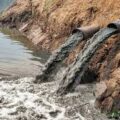
Plastic is the most prevalent type of marine debris found in our ocean and Great Lakes. Even though plastic pollution is a well-known worldwide problem, the discovery of the presence of microplastics in seas and oceans represents an unexpected and alarming turn in this environmental challenge. Plastic debris can come in all shapes and sizes, but those that are less than five millimeters in diameter are called “microplastics.” Microplastics are small plastic particles in the environment. They can come from a variety of sources, including cosmetics, clothing, and industrial processes. Microplastics represent approximately 92.4% of the global particle count of plastic litter. These small plastic items are entering the marine environment and adding pressure to an already vulnerable system. As an emerging field of study, not a lot is known about microplastics and their impacts on the environment. Microplastics are likely the most numerically abundant items of plastic debris in the oceans today and the quantities will inevitably continue to increase. According to UN News, as many as 51 trillion microplastic particles (500 times more than the stars in our galaxy) litter the seas and oceans, seriously threatening marine wildlife, and possibly humans.
Sources of microplastics
Microplastics come from two main sources; primary and secondary. Primary microplastics are those that are manufactured purposely for use including plastic pellets – or ‘nurdles’ – that act as base material for plastic production from industry, microbeads that are added as exfoliants to health and beauty products, such as some cleansers, household cleaning products, toothpastes, and synthetic fibres from clothes washed out by washing machine. These tiny particles easily pass through water filtration systems and end up in the ocean and Great Lakes, posing a potential threat to aquatic life. Secondary microplastics on the other hand are those microplastics that are formed when larger plastic debris fragment into smaller pieces.
According reports, between 15 and 31% of the estimated 9.5 million tonnes of plastic released into the oceans annually could be primary microplastics, almost two-thirds of which come from the washing of synthetic textiles and the abrasion of tyres while driving. This report is a real eye-opener, showing that plastic waste is not all there is to ocean plastics. Our daily activities, such as washing clothes and driving, significantly contribute to the pollution choking our oceans, with potentially disastrous effects on the rich diversity of life within them, and on human health.
Distribution and impact of microplastics
Microplastics are dispersed throughout the world’s ocean. They have been found distributed in large concentrations in Africa, Asia, Southeast Asia, India, South Africa, North America, and in Europe, often found in shorelines, seabed sediments, inland waters, soils, food webs, indoor and outdoor air, beaches, wastewater effluents and even frozen ice. Some float on surface waters and some are found within the Artic and the Antarctic, transported by ocean currents and wind. The small size of microplastics makes them easily available for ingestion by a wide range of organisms in the marine environment. Better researched is their ability to be easily ingested by marine organisms. Fish, seabirds mistake microplastics for prey, while filter feeders like whales and mussels filter them from the water alongside particles of food. In this way, they can also enter the diet of both birds and humans, who eat the animals who have eaten the plastics. Plastics often contain chemicals to give them specific properties, which in many cases are toxic. These can be released inside the animal, causing problems.
Several studies have demonstrated that marine organisms can take up microplastics often with great consequences as they can accumulate in the tissues, serve as vehicles for transport of pathogens, and adsorb and accumulate toxic pollutants. Microplastics have the potential to cause many adverse effects such as cancer, pathological stress, false satiation, reproductive complications, oxidative stress, block enzyme production, decreased growth rate, impaired reproductive activity, genetic disruption, decreased immune response, and malformation in animals and potentially in humans if ingested in high quantities. Also, there is growing scientific evidence linking them to the passage of deadly, persistent toxic chemicals through the environment, such as the pesticide DDT and toxic PCBs, making them more concentrated when they come into contact with marine life and possibly humans. The presence of microplastic particles in the marine environment could also have other implications such as transporting microorganisms which colonize their surfaces to new places where they might be harmful to changing properties of sediment, we are only beginning to understand how harmful they are to the marine environment.
Scientists have demonstrated that fish exposed to microplastics during their development show stunted growth and increased mortality rates, as well as changed behavior that could endanger their survival. Reports have it that by the year 2050, there will be more microplastics in our oceans than fish.Fish is an excellent of protein. The fatty fish are a great source of vitamin D. Fish is also a great source of iron and omega-3 fats that are really important in terms of our heart health.
Abiotic sea products are a source of food for humans and there is a possibility that the presence of microplastics in the sea could lead to the contamination of sea products and potential transfer to humans. One of such products is sea salt. The presence of microplastics in sea salt has recently been proven through several scientific studies. This demonstrates that along with fish and shellfish (seafood), table salt also appears to be contaminated by microplastics.
Pollution of the marine environment by microplastics is a potential health and economic problem. Prevention and possible management measures have been listed as a challenge because these particles are very small and hard to visualize, which makes their manual removal very difficult, if not impossible. Also, the rate at which microplastics enter the environment supersedes the rate of removal.
Helen Shnada Auta is a PhD Student at the Institute of Biological Sciences Faculty of Science, University of Malaya, Kuala Lumpur Malaysia
SEE: WATER POLLUTION





An eye opener. More power to you ma.